
The United Arab Republic was a sovereign state in the Middle East from 1958 until 1971. It was initially a political union between Egypt and Syria from 1958 until Syria seceded from the union after the 1961 Syrian coup d'état. Egypt continued to be known officially as the United Arab Republic until 1971.

The flag of Iraq includes the three equal horizontal red, white, and black stripes of the Arab Liberation flag, with the phrase “God is the greatest” written in Kufic script in the center.

The flag of the Kingdom of Saudi Arabia is the flag used by the government of Saudi Arabia since 15 March 1973. It is a green flag featuring in white an Arabic inscription and a sword. The inscription is the Islamic creed, or shahada: "There is no deity but God; Muhammad is the Messenger of God".

The flag of Yemen was adopted on May 22, 1990, the day that North Yemen and South Yemen were unified. The flag is essentially the Arab Liberation Flag of 1952, introduced after the Egyptian Revolution of 1952 in which Arab nationalism was a dominant theme. The Arab Liberation Flag of 1952 served as the inspiration for the flags of both North and South Yemen prior to unification, as well as for the current flags of Egypt, Iraq, Sudan and Syria.
This gallery of sovereign state flags shows the national or state flags of sovereign states that appear on the list of sovereign states. For other flags, please see flags of active autonomist and secessionist movements, flags of extinct states and gallery of flags of dependent territories. Each flag is depicted as if the flagpole is positioned on the left of the flag, except for those of the Islamic Emirate of Afghanistan, Iran, Iraq, and Saudi Arabia, which are depicted with the hoist to the right.
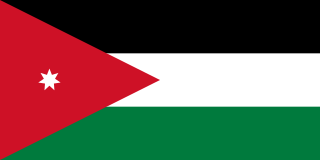
The flag of Jordan, officially adopted on 16 April 1928, is based on the 1916 flag of the Arab Revolt against the Ottoman Empire during World War I. The flag consists of horizontal black, white, and green bands that are connected by a red chevron. The colours are the Pan-Arab Colors, respectively representing the Abbasid, Umayyad, and Fatimid or Rashidun caliphates. The red chevron is for the Hashemite dynasty, and the Arab Revolt.

The national flag of Egypt is a tricolour consisting of the three equal horizontal red, white, and black bands of the Egyptian revolutionary flag that dates back to the 1952 Egyptian Revolution. The flag bears Egypt's national emblem, the Egyptian eagle of Saladin, centered in the white band.

The current flag of Sudan was adopted on 20 May 1970 and consists of a horizontal red-white-black tricolour with a green triangle at the hoist. The flag is based on the Arab Liberation Flag of the Egyptian Revolution of 1952, as are the flags of Egypt, Iraq, Syria, Yemen, and Palestine and formerly of the United Arab Republic, North Yemen, South Yemen, and the Libyan Arab Republic.
As a result of the Syrian Civil War since 2011, there are at least two flags used to represent Syria, used by different factions in the war. The incumbent government of the Syrian Arab Republic led by the Ba'ath Party uses the red-white-black tricolour originally used by the United Arab Republic, while Syrian opposition factions such as the Syrian National Coalition use the green-white-black tricolour known as the ''Independence flag'', first used by Mandatory Syria.

The national flag of the United Arab Emirates contains the Pan-Arab colors red, green, white, and black. It was designed in 1971 by Abdullah Mohammed Al Maainah, who was 19 years old at that time, and was adopted on 2 December 1971. The main theme of the flag's four colors is the unity of Arab nations. In 2008, there was a minor change to the Emblem.
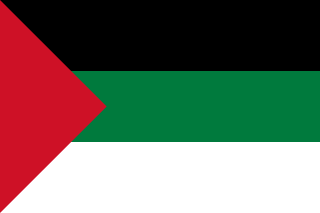
The Pan-Arab colours are black, white, green and red. Individually, each of the four Pan-Arab colours were intended to represent a certain aspect of the Arabs and their history. The black represents the Black Standard used by the Rashidun and Abbasid caliphates, white was the dynastic colour of the Umayyad and Fatimid caliphates, Green is a colour associated with the primary religion of Islam – and therefore also a color representative of Rashidun Caliphates, and red was the Hashemite dynastic colour. The four colours also derived their potency from a verse by 14th century Iraqi poet Safi al-Din al-Hilli: "White are our acts, black our battles, green our fields, and red our swords".

The coat of arms of Egypt is known as the Republican Eagle or Egyptian Golden Eagle, is a heraldic golden eagle, facing the viewer's left (dexter). The eagle's breast is charged with an escutcheon bearing the red-white-black bands of the flag of Egypt rotated vertically, whilst the eagle's talons hold a scroll bearing the official name of the state written in Kufic script. The earliest version of the Eagle of Saladin was that used as the flag of Saladin, the first Sultan of Egypt, whilst the modern version of the eagle was adopted during the Egyptian Revolution of 1952. Subsequently, the modern design of the Eagle of Saladin was adopted as the coat of arms of numerous other states in the Arab World, namely the United Arab Republic, North Yemen, Iraq, South Yemen, the Libyan Arab Republic, and Palestine. The current eagle was modified in 1984 to its present form.

The flag of Palestine is a tricolor of three equal horizontal stripes overlaid by a red triangle issuing from the hoist. This flag is derived from the Pan-Arab colors and is used to represent the State of Palestine and the Palestinian people. It was first adopted on 28 May 1964 by the Palestinian Liberation Organization. The flag day is celebrated on 30 September.
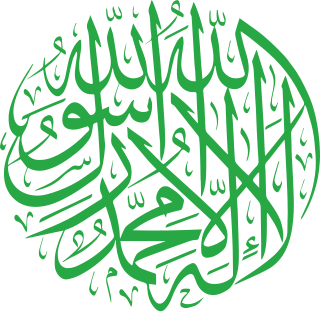
Islam is an Abrahamic monotheistic religion teaching that there is only one God (Allah) and that Muhammad is the last messenger of God. It is the world's second-largest religion, with over 1.9 billion followers, and Muslims form 24.4% of the world's population.
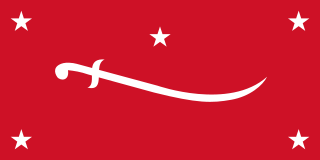
The Mutawakkilite Kingdom of Yemen, also known simply as the Kingdom of Yemen or as Yemen, or, retrospectively, as North Yemen, was a state that existed between 1918 and 1962 in the northwestern part of what is now Yemen. Its capital was Sana'a until 1948, then Taiz. From 1962 to 1970, it maintained control over portions of Yemen until its final defeat in the North Yemen Civil War. Yemen was admitted to the United Nations on 30 September 1947.
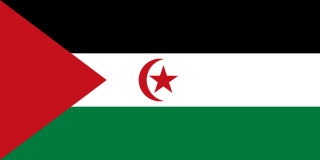
The flag of Western Sahara also known as Sahrawi Arab Democratic Republic uses a national flag consisting of a black, white and green horizontal tricolor charged with a red star and crescent in the center stripe and a red chevron at the hoist. It is used on Polisario-controlled areas, while the Moroccan flag is used on the rest of the occupied territory.

The current coat of arms of Syria or coat of arms of the Syrian Arab Republic was adopted in 1980, following the 1977 dissolution of the Federation of Arab Republics, whose coat of arms had until then been used by its constituent states. This emblem consist of the Hawk of Quraish supporting a shield bearing the national flag of Syria, and a scroll of the words "Syrian Arab Republic". Since the start of the ongoing Syrian Civil War in March 2011, alternative coats of arms have been created by the Syrian opposition and the Federation of Northern Syria.
An Islamic flag is a flag either representing an Islamic Caliphate or religious order, state, civil society, military force or other entity associated with Islam. Islamic flags have a distinct history due to the Islamic prescription on aniconism, making particular colours, inscriptions or symbols such as crescent-and-star popular choices. Since the time of the Islamic prophet Muhammad, flags with certain colours were associated with Islam according to the traditions. Since then, historical Caliphates, modern nation states, certain denominations as well as religious movements have adopted flags to symbolize their Islamic identity.

The flag of the Arab Revolt, also known as the flag of Hejaz, was a flag used by the Arab nationalists during the Arab Revolt against the Ottoman Empire during World War I, and as the first flag of the Kingdom of Hejaz.















